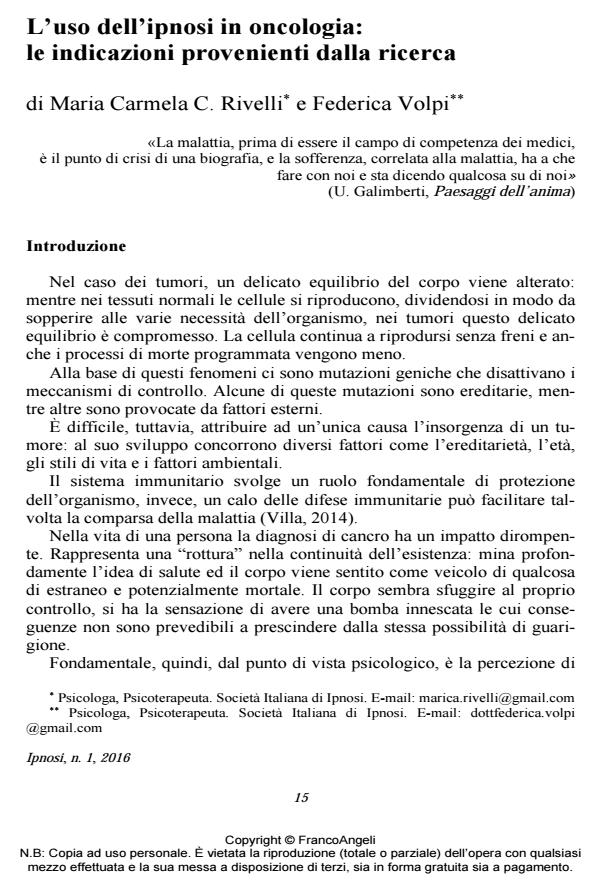L’uso dell’ipnosi in oncologia: le indicazioni provenienti dalla ricerca
Journal title IPNOSI
Author/s Maria Carmela C. Rivelli, Federica Volpi
Publishing Year 2016 Issue 2016/1
Language Italian Pages 10 P. 15-24 File size 189 KB
DOI 10.3280/IPN2016-001002
DOI is like a bar code for intellectual property: to have more infomation
click here
Below, you can see the article first page
If you want to buy this article in PDF format, you can do it, following the instructions to buy download credits

FrancoAngeli is member of Publishers International Linking Association, Inc (PILA), a not-for-profit association which run the CrossRef service enabling links to and from online scholarly content.
The use of hypnosis in oncology: indications from the research. Hypnosis is applied at various levels in cancer care. Several studies show the effectiveness of hypnosis to treat the symptoms of the disease (pain, malaise, irritability and insomnia etc.); in the management of the side effects of cancer treatments; to improve the quality of life and deal with the psychological distress related to the health; for its effects on the immune system. The Authors point out that studies on the effects of hypnosis in activating psyconeuroimmunology mechanisms, which may be useful to modulate disease progression and response to treatment, is a very interesting and promising area of study. In this context, however, research is still lacking, because systematic and controlled trials on the effects of hypnotherapy on the immune system, on the relapse rate and long-term survival of cancer patients are needed.
L’ipnosi trova applicazioni a vari livelli nella cura del cancro. Diversi studi mostrano l’efficacia dell’ipnosi come mezzo per trattare i sintomi della malattia stessa (dolore, malessere, irritabilità e insonnia ecc.); nella gestione degli effetti collaterali delle terapie antitumorali; per migliorare la qualità della vita e affrontare il disagio psicologico correlato allo stato di salute; per i suoi effetti sul sistema immunitario. Gli Autori sottolineano che le ricerche sugli effetti dell’ipnosi nell’attivazione di meccanismi psiconeuroimmunologici, che potrebbero risultare utili per modulare l’evoluzione della malattia e la risposta ai trattamenti, rappresentano un settore di studio molto interessante e promettente. In questo ambito, però, la ricerca è ancora carente, in quanto sono necessari studi controllati e sistematici sugli effetti dell’ipnoterapia sul sistema immunitario, sul tasso di recidiva e sulla sopravvivenza a lungo termine dei pazienti oncologici.
Keywords: Hypnosis, cancer, pain, immune system, emesis, coping.
Maria Carmela C. Rivelli, Federica Volpi, L’uso dell’ipnosi in oncologia: le indicazioni provenienti dalla ricerca in "IPNOSI" 1/2016, pp 15-24, DOI: 10.3280/IPN2016-001002